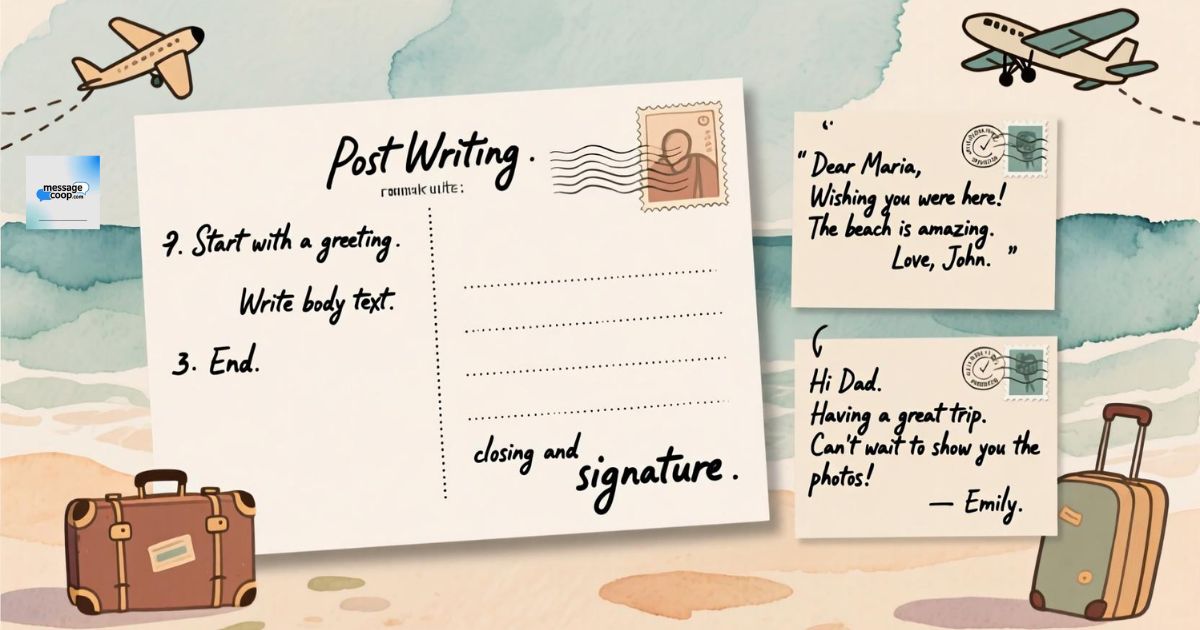Post card messages are a timeless way to share feelings, travel stories, and warm greetings. Whether you’re sending a note from a holiday destination or just expressing gratitude, post card messages add a personal touch. They capture emotions in simple words and let your recipient feel remembered. Writing post card messages is not only about communication but also about creating memories that last.
People use post card messages for many reasons: to say thank you, send love, or simply brighten someone’s day. Adding short greetings, travel notes, or creative words makes every card unique. A handwritten note with thoughtful post card messages can strengthen relationships, celebrate milestones, and spread positivity. By choosing the right words and adding your heart, post card messages become more than writing, they become cherished keepsakes.
Understanding Postcards
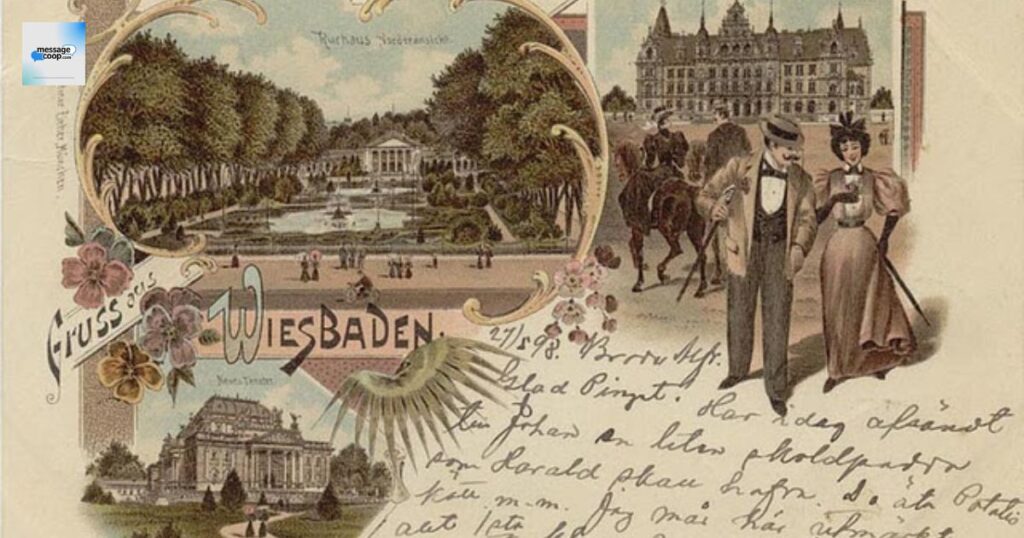
Postcards are more than just paper; they are memories, travel notes, and art. They carry handwritten words, unique designs, and become treasured souvenirs or keepsakes. From vintage collections to modern prints, postcards reflect culture, history, and emotion.
This section explores what postcards are, their past, purpose, and different types.
What is a Postcard?
- A postcard is a rectangular card designed for short handwritten personal messages.
- One side displays an image, while the other holds notes and addresses.
- Postcards are simple, affordable, and require no envelope for mailing worldwide.
- They are used for greetings, travel updates, or sharing thoughtful sentiments.
- Businesses often use postcards for marketing, promotions, or creative advertisement campaigns.
- Collectors treasure postcards for their artwork, stamps, and historical printed designs.
- Postcards provide a personal touch unmatched by instant digital communication tools.
- They are compact, lightweight, and easy to send across any destination.
- A postcard often combines visual imagery with heartfelt words and personal expression.
- Postcards remain timeless, bridging communication with memory and cultural significance beautifully.
Brief History of Postcards
- The first official postcard appeared in Austria in the year 1869.
- Other European countries quickly embraced postcards as cost-effective communication methods.
- In 1873, the United States began producing its first government-issued postcards.
- By the 1900s, postcards became popular worldwide as souvenirs and collectible items.
- Early postcards featured simple designs, later evolving into illustrations and photographs.
- The 1900–1915 period was the “Golden Age” of postcard collecting.
- Vintage postcards now reflect culture, history, and artistic movements of past times.
- They preserved images of cities, landmarks, and daily life for generations.
- Over decades, postcard designs adapted to modern tastes and printing techniques.
- Today, postcards still connect people while preserving history and meaningful memories.
Why Send Postcards?
- Sending postcards shows thoughtfulness and effort, unlike quick instant digital messages.
- A postcard is a physical keepsake recipients can treasure and display.
- Handwritten notes add warmth and emotion that electronic words cannot match.
- Travelers share postcards to describe adventures and destinations with loved ones.
- They create personal bonds, strengthening relationships across distances and cultures.
- Postcards are inexpensive yet powerful communication tools with lasting emotional impact.
- Receiving a postcard feels personal, meaningful, and surprisingly heartwarming today.
- Postcards preserve traditions of handwritten communication in a digital-first age.
- They add charm, nostalgia, and artistic beauty to ordinary everyday connections.
- Sending postcards shows care, reminding recipients they’re valued and remembered deeply.
Types of Postcards
- Travel postcards showcase famous destinations, beautiful landmarks, and cultural highlights globally.
- Art postcards feature paintings, drawings, or unique contemporary creative designs.
- Vintage postcards are prized collectibles reflecting history, culture, and past artistry.
- Photo postcards allow personalization using the sender’s own pictures and captured memories.
- Souvenir postcards are purchased during travels to keep memories or share.
- Greeting postcards carry thoughtful wishes for birthdays, weddings, or celebrations.
- Humorous postcards bring laughter with cartoons, witty jokes, or lighthearted art.
- Advertising postcards promote businesses, services, events, or creative campaigns effectively.
- Cultural postcards highlight traditions, festivals, or heritage symbols of communities.
- Limited-edition postcards are rare prints collected by enthusiasts and hobbyists.
Choosing a Postcard
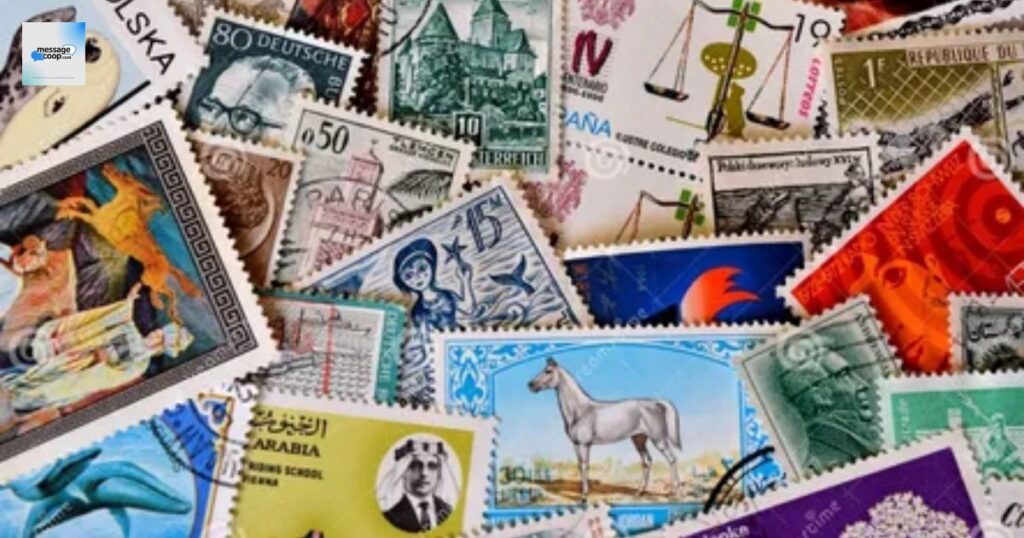
Selecting the right postcard makes your message more memorable and meaningful. Every postcard reflects artwork, travel stories, or personal creativity in its design. From souvenir keepsakes to personalized creations, your choice sets the tone beautifully. Here’s how to choose a postcard that truly fits your purpose.
Consider your Purpose
- Decide if the postcard is for travel memories, celebrations, or personal keepsake.
- Postcards for business promotions differ greatly from those meant for friends.
- Your postcard’s purpose determines design, tone, and overall writing style.
- Sentimental postcards are best for heartfelt words expressing deep emotions.
- Lighthearted postcards work well for humor, jokes, or cheerful greetings.
- For professional use, choose sleek designs matching your business image.
- Travelers often select postcards highlighting destinations, landmarks, and cultural sites.
- Special events require postcards tailored with specific seasonal or festive designs.
- Collectors seek unique postcards with value, history, or artistic importance.
- Knowing purpose ensures the postcard chosen aligns perfectly with the sender’s intentions.
Look for Postcards that Suit your Needs
- Choose postcards with images matching mood, style, and communication message.
- For personal messages, pick designs evoking warmth, intimacy, or nostalgia.
- For souvenirs, select iconic landmarks representing the destination’s cultural or natural beauty.
- Humor postcards are ideal when spreading laughter and cheerful feelings.
- Artistic postcards highlight creativity, colors, and visual appeal through unique artwork.
- Business postcards should reflect professionalism, branding, and sleek minimalistic designs.
- Cultural postcards honor traditions, local heritage, or unique lifestyle elements.
- Vintage-themed postcards add charm, history, and timeless character to messages.
- Personalized photo postcards suit travelers wanting to share real-life captured moments.
- Always pick postcards aligning with emotions, occasion, and intended recipient.
Purchase or Create your Postcards
- Postcards are available at bookstores, gift shops, and tourist souvenir stands.
- Online platforms offer vast postcard designs with customizable creative options.
- Craft stores often provide materials to design and personalize handmade postcards.
- Creating postcards adds sentimental value through originality, effort, and creativity.
- Printed photo postcards let senders transform travel pictures into meaningful communication.
- Purchasing bulk postcards benefits businesses running promotional or marketing campaigns.
- Local markets often sell cultural postcards reflecting traditions, art, and identity.
- Digital services allow designing postcards online and mailing them directly.
- Creating personalized postcards ensures uniqueness, authenticity, and heartfelt emotional touch.
- Both purchasing and creating options depend on purpose, creativity, and preference.
Composing Your Message

Writing a postcard message brings a personal touch to your communication. It’s a chance to share travel experiences, emotions, and thoughtful greetings. A short handwritten note can feel more intimate and heartfelt than digital.Here’s how to create a postcard message that connects with your recipient.
Begin with a Greeting
- Start with a friendly hello to immediately create warmth and connection.
- Use cheerful greetings that set a positive mood for your postcard.
- Begin with “Dear” for formal tone or “Hey” for casual vibe.
- Greeting helps establish emotional closeness right from the very beginning.
- A sincere greeting shows thoughtfulness and respect for the postcard’s recipient.
- Using first names makes your greeting more personal and heartfelt.
- Seasonal greetings like “Happy Holidays” suit festive postcard occasions perfectly.
- Warm greetings make even short postcards feel special and more appreciated.
- A postcard without greeting feels incomplete, impersonal, and less inviting.
- Keep the greeting short, clear, and aligned with your postcard’s overall purpose.
Personalizing the Greeting based on the Recipient
- Address the recipient by name to show attention, care, and genuine respect.
- Add affectionate nicknames when writing postcards for close friends or partners.
- Formal greetings work better for professional contacts, clients, or distant relatives.
- Tailoring greetings builds emotional bridges between sender and recipient instantly.
- Use cultural or language-specific greetings for authenticity and deeper connection.
- Personalization shows postcards aren’t generic but specially crafted for them.
- Family members appreciate heartfelt greetings filled with warmth and love.
- Friends enjoy playful greetings that reflect shared experiences and inside jokes.
- Romantic greetings work best for partners, strengthening bond through heartfelt words.
- Customized greetings set the tone for the entire postcard message effectively.
Share your Experience
- Describe beautiful scenery, sights, and landmarks from your travel adventure.
- Share local culture, food, and traditions you recently enjoyed while traveling.
- Talk about memorable moments that highlight your journey’s unique experiences.
- Mention exciting activities or adventures you participated in during the trip.
- Write about interesting people you met and their inspiring personal stories.
- Share emotions you felt while exploring new places and unfamiliar surroundings.
- Talk about weather conditions and how they affected your travel experience.
- Mention unexpected surprises that made your journey more memorable and exciting.
- Share comparisons between home and destination, highlighting unique cultural contrasts.
- Give small travel tips in postcards, helpful for future visiting recipients.
Ask Questions
- Questions invite response and keep communication alive beyond postcard delivery.
- Ask the recipient about their day, activities, or recent exciting experiences.
- Simple questions like “How are you?” always create meaningful connections.
- Inquire about family updates, ensuring the recipient feels remembered and valued.
- Travel postcards can include “Have you visited this place before?”
- Casual questions make postcards feel like ongoing conversations, not one-sided.
- Ask about upcoming holidays, events, or celebrations recipients may enjoy.
- Questions about shared hobbies create instant connection between sender and receiver.
- Curious questions reflect genuine interest in the recipient’s well-being and life.
- Ending with a question encourages replies through letters, postcards, or messages.
Sign off
- End message with warm closing lines to leave a lasting positive impression.
- Use “With love” or “Best wishes” for personal and emotional touch.
- Professional postcards can close with “Sincerely” or “Kind regards” instead.
- Casual sign offs like “See you soon” create a relaxed, friendly tone.
- Add name clearly so the recipient knows the postcard is personally written.
- Romantic postcards often end with “Forever yours” or affectionate closing lines.
- Include fun doodles or small drawings to make sign-off creative.
- Consistent sign-off style builds recognition across multiple postcards sent.
- Sign-off is important, completing the message and maintaining the postcard’s emotional value.
- A thoughtful closing ensures the recipient remembers the message long after reading.
Addressing and Sending Your Postcard
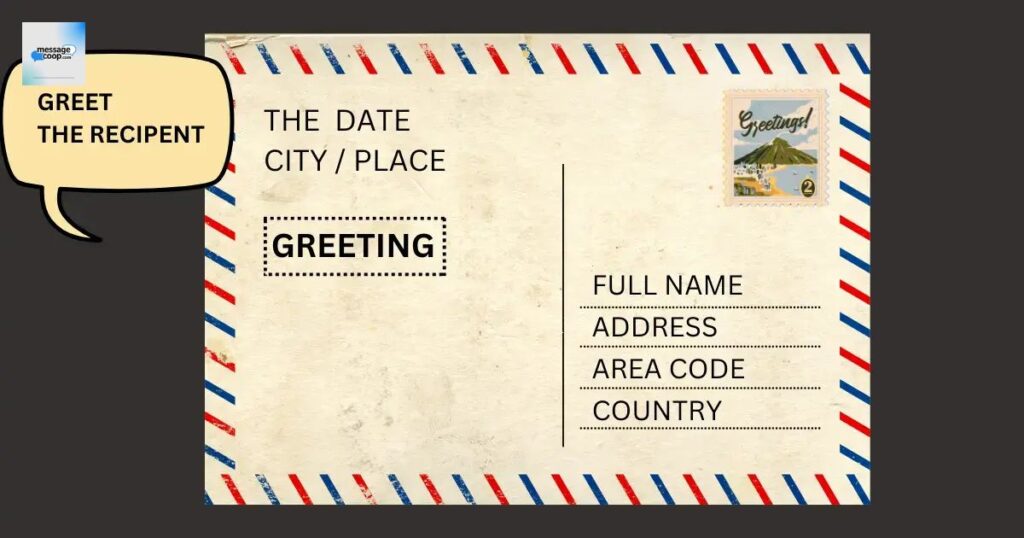
Sending a postcard involves more than writing a message. Correct addressing, adding postage, and mailing ensure your postcard reaches safely. A well-addressed postcard shows care and respect toward the recipient. Follow these steps to make postcard sending smooth and stress-free.
Addressing your Postcard
- Always write the recipient’s full name clearly to avoid delivery issues later.
- Include street name and number for accurate and timely postcard delivery.
- Write city and postal code to ensure correct sorting and routing.
- Use block letters for better readability by postal workers handling mail.
- Place address on right-hand side, leaving left side for message.
- Double-check address before mailing to prevent postcards from getting lost.
- For international delivery, include the country name in clear bold writing.
- Use proper spacing between lines for neat and organized address format.
- Avoid abbreviations unless commonly recognized by local postal systems.
- Clear addressing ensures the postcard arrives safely, creating happy recipient moments.
Adding Postage
- Postage stamps show payment for delivery, making postcard travel possible.
- Choose the correct stamp value depending on destination, domestic or international.
- Buy stamps from post offices or authorized postal retailers nearby.
- Place the stamp neatly in the top-right corner of the postcard back.
- Incorrect postage can delay or return a postcard before reaching the recipient.
- Decorative stamps add charm, enhancing postcard’s overall presentation beautifully.
- Check the country’s postal rates before sticking stamps to avoid mistakes.
- Ensure stamp adheres firmly so it doesn’t peel during transit.
- For collectibles, unique stamps make postcards more memorable and special.
- Adding postage correctly guarantees the postcard travels smoothly to its destination.
Sending your Postcard
- Drop postcards into the nearest mailbox for quick and easy sending.
- Post offices provide secure sending services for domestic and international destinations.
- Some hotels offer mailing services, convenient during travel stays abroad.
- Always send postcards early to ensure timely arrival before events.
- Keep postal holidays in mind, which may cause delivery delays.
- Mailing overseas may require customs checks, depending on the destination country.
- Sending postcards spreads happiness, memories, and personal connections worldwide.
- Tracking services sometimes available for high-value or bulk postcard mailing.
- Sending multiple postcards together saves time and reduces postage trips.
- Posting a card is simple, meaningful, and full of charm.
Tips and Warnings
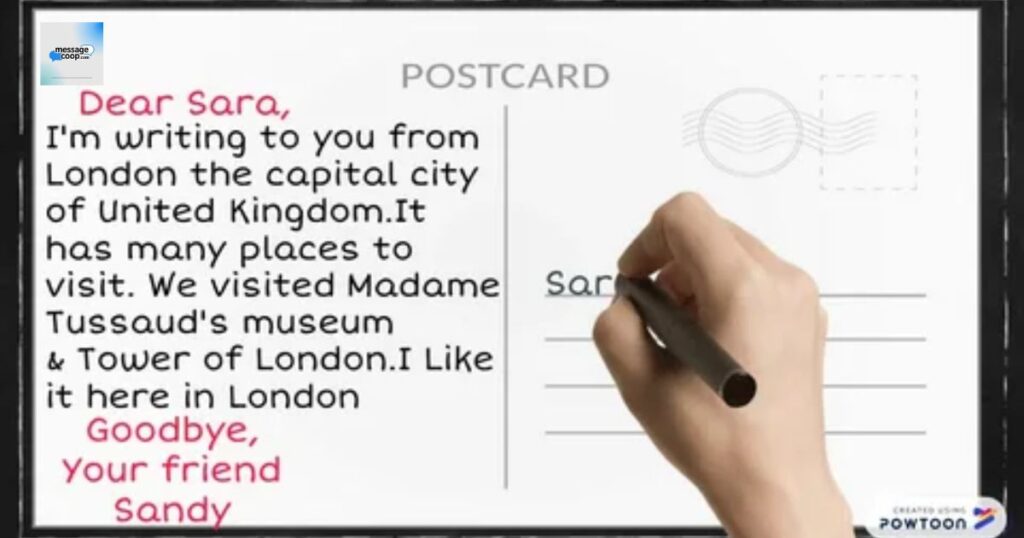
Writing a postcard is simple, but some tips make it more effective. A thoughtful postcard combines clarity, warmth, and creativity in its short message. Avoiding common mistakes ensures your postcard is delivered without problems. Follow these guidelines for meaningful, memorable, and successful postcard communication every time.
Tips for Writing a Great Postcard
- Start with a warm greeting that instantly connects you with the recipient personally.
- Keep sentences short, making messages easy to read and understand.
- Share highlights of your trip or experiences to make postcards memorable.
- Add small details about places, culture, or food for personal touch.
- Write neatly, ensuring the recipient can read messages without unnecessary difficulty.
- Use colorful pens or decorative touches for added creativity and charm.
- Always mention the recipient’s name for a personal and friendly tone.
- Leave space for address and stamp when writing your postcard message.
- Keep language simple and positive, spreading joy through heartfelt words.
- End with love, regards, or thoughtful sign-off to create lasting impressions.
Common Mistakes to Avoid
- Forgetting to add postage prevents postcards from being delivered on time.
- Writing address unclearly may cause postcards to be lost or undelivered.
- Using very long sentences reduces readability on small postcard space.
- Forgetting the recipient’s name makes postcards feel less personal and meaningful.
- Overfilling a card with text leaves no space for proper addressing.
- Using pencils may smudge, making messages hard to read clearly.
- Avoid writing private details since postcards are not confidential communications.
- Incorrect international format can delay delivery or return your postcard unexpectedly.
- Not checking postal holidays may result in delayed or late delivery.
- Avoid messy handwriting which makes postcards difficult for recipients to enjoy.
Sample Postcards
Looking at sample postcards helps you understand proper structure and writing style. Each postcard example shows how to mix greetings, experiences, and thoughtful messages. These templates guide you in writing warm, personal, and memorable postcard communication. Use them as inspiration when creating your own creative travel postcards.
Example Postcard 1
Dear Sarah,
Greetings from Paris! The Eiffel Tower at night is absolutely breathtaking. Today, I enjoyed fresh croissants in a cozy café near the river. The city feels alive with art, history, and music. I wish you were here to see it with me. Sending love and warm thoughts across the miles.
Best,
Emily
Example Postcard 2
Hi David,
I’m writing from sunny Bali! The beaches here are golden and peaceful. Yesterday, I went snorkeling and saw colorful fish swimming through coral reefs. The sunsets are magical, painting the sky with orange and purple shades. I hope everything is great back home. Can’t wait to share more stories soon!
Cheers,
Anna
FAQ’s
How to Write a Postcard?
Keep your note short and personal, focusing on warm greetings and little details. Add thoughtful post card messages to make your writing memorable and heartfelt.
How to Write on a Postcard?
Start with a greeting, share experiences, and close with a friendly sign-off. Personal post card messages create warmth, connection, and emotional value for the recipient.
How to Write a Postcard Address?
Place the recipient’s name, street, city, and postal code clearly on the right side. Add post card messages on the left for balance and clarity.
How to Write an Address on a Postcard?
Use block letters for the recipient’s information to ensure easy readability. Keep post card messages short, so they don’t overlap with the address section.
How to Write a Postcard to a Friend?
Write casually with humor or warmth, depending on your relationship. Adding personal post card messages makes your friend feel valued and strengthens your friendship bond.
Read More :20+ Thanks for Coming Messages – Sincere Words
Conclusion
Post card messages are simple yet meaningful ways to connect with people. They carry emotions, love, and memories in just a few words. A short line or thoughtful note in post card messages can bring a smile and brighten someone’s day. With handwritten notes, post card messages feel more personal and heartfelt.
Sharing post card messages helps celebrate milestones, holidays, and travel experiences. They are also great for sending gratitude, friendship, or romantic feelings. By keeping post card messages short, warm, and easy to read, they remain special and timeless. Whether for family, friends, or loved ones, post card messages make communication more personal. Every card becomes a memory to treasure, proving that post card messages are always a beautiful way to stay connected.

